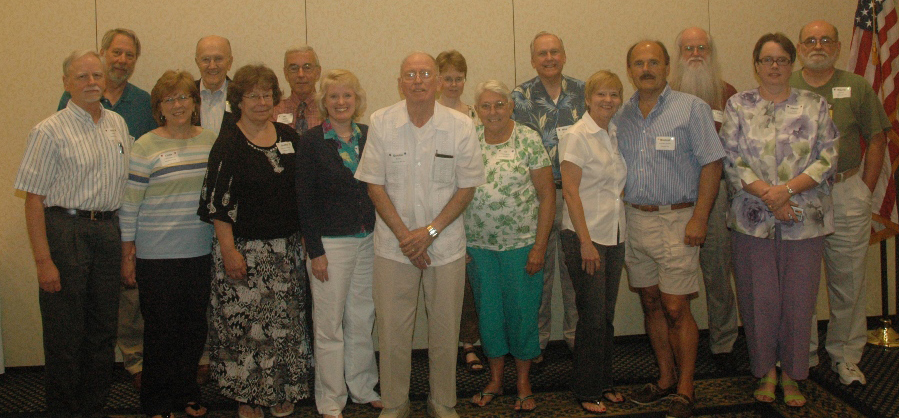What could be better than getting together with a Mx cousin? Getting together with
20 of them, by blood or by marriage, in the heart of colonial America! That is what
happened August 17 -19, 2012, at the Mx Genealogy Workshop in Waynesboro, Virginia.
While it didn’t rival the 1988 reunion in Europe, it was certainly an exciting time
for those of us who were able to attend.
The weekend kicked off with dinner on Friday evening, including Steve and Bonnie
Mullinax (US312) favoring us with their rendition of the very humorous song, “I’m
My Own Grandpa.”
Saturday was jam-packed. After an invocation by my Uncle Gordon Mullinax (US284),
Charles Molineaux (US137) gave a great overview and historical background of some
of our colonial Mx ancestors. With our brains in gear, we were ready for three presentations:

Left to right: Ron & Linda Mullennex (US293), Steve Mullinax (US312; wife, Bonnie,
not pictured), Charles Molineaux (US137), Dottie & Ian Molineaux, Wendy Mullinax
(US339), Gordon & Di Mullinax (US284), Julie Mullinax Crawford (US409), Mike Mullinax
(wife, Bobbie, not pictured), Paula & Michael Mullineaux (US323), David Nation (US410;
wife, Becky, not pictured), Nancy Mullinax Stamper, Wayne Straight (US332; wife,
Gloria, not pictured)
By the time we made it to the Round Table Discussions, we were anxious to start
sharing our knowledge, theories and questions about our respective Mx Lines. Although
the DNA R-Haplogroup was small, there was a real excitement as Wayne led them in
a discussion specific to their group. Represented in this group were Mxes from the
Sullivan County (PA) and Branford (CT) Lines and from what may prove to be the Westhoughton
Line. Since the workshop, we believe that Wayne has helped Paula trace her Mx tree
back additional generations!
The DNA I-Haplogroup broke into two groups, one led by Charles and the other led
by Wendy. Charles’ group focused largely on the Delaware branch of the tree, allowing
those in the group with roots in South Carolina and Virginia to learn more about
the branch of the Mx tree to which they are tied through DNA. In addition to learning
more about the Delaware branch of the Mx tree, Wendy’s group shared in some
detail with each other about John Mx (m. Alsey) and Johnson Mx, each from the Spartanburg
(SC) Line but without a specific known connection. It was exciting to learn that
early descendents of each of these Mxes gave similar stories ---- coming from Ireland
and passing through Rockingham or Pendleton County, Virginia. Later in the day,
theories emerged from another group discussion as to how the Delaware, Virginia,
South Carolina, and Tennessee Lines might be related. Stay-tuned for additional
information on this very exciting lead!
Back to Top ...
Workshop Photo Gallery
Presentations & Round Table Discussions
The Other Side of the Big Pond: Our European Roots
Not many families can boast of 1000 years worth of continuous recorded history,
but ours can! The Mx name, Coat of Arms, and the significance of William the Conqueror
to our family will be discussed. With a desire to find clues as to our respective
ancestor’s whereabouts prior to coming to this side of the Big Pond, we will also
learn about Europe during the 16th, 17th and 18th centuries, with special emphasis
on France, England, and Ireland. Emigration ---- who, why, and from where ---- will
also be examined.
DNA: The Tie That Binds
DNA (deoxyribonucleic acid) will be explained in such a way that will be easy to
understand and utilized in your family tree research. Since more than 50 Mx men
have already joined the Molyneux Surname Project, we will be able to share what
has already been learned, as well as discuss which Mx Lines would be most beneficial
to test next. Each “Mx Line” includes those who share a known, or suspected, ancestor.
You will learn into which of these Lines you fall and, hopefully, be able to use
the knowledge you have of your branch of the Mx tree to help fine-tune IMFA’s Mx
relational analysis strategy which was set up to aid in research and collaboration.
Genealogical Analysis & Integrity
Want to enhance your genealogical research and produce quality records for both
current and future generations? In this segment we will first touch upon the art
and science of genealogical research, providing examples of cognitive tools and
methods borrowed from a number of analytic disciplines. Next, we will delve into
the level of personal and data integrity necessary for you to produce a quality
record of your family research. Finally, we will discuss the nature and genealogical
rules of “evidence,” as well as some terminology used in describing the quality
and validity of that evidence.
This Side of the Big Pond: Colonial America and Beyond
Most Mxes living in America today can trace their Mx ancestors to colonial times.
Many of these Lines, however, do not yet know how they are related. It is our hope
that by learning more about migration patterns, ports of entry, ethnic affiliations,
and other aspects of Colonial America, we will be better able to connect the dots.
Since it is believed that at least some of our Mx ancestors came through Canada
and the Caribbean Islands, they will also be explored.
Round Table Discussions
All of the above will act as a springboard for the round table discussions. Although
the level of research done by those attending the reunion will vary, each person
will be able to contribute either with what they know or with questions about what
they don’t know. The former will help us pool our various areas of expertise, while
the latter will help us better analyze the strength of any particular train of thought.
This will be an exciting time of collaboration!